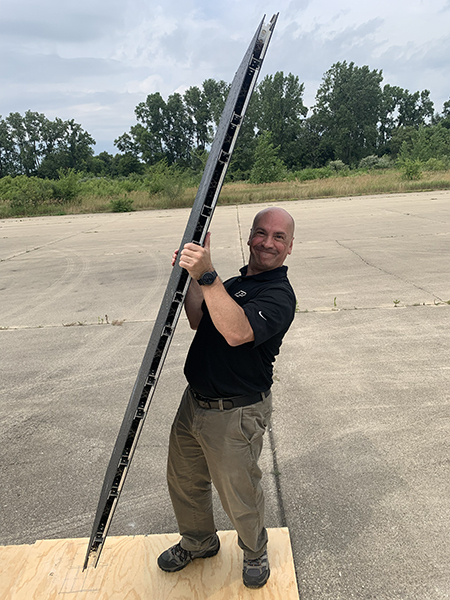Intelligent Architected Materials Take Shape
A new class of materials designed by Purdue researchers is being tested for aircraft runway mats, nonpneumatic tires, and other applications.

Aircraft runway mats made with the new intelligent materials were capable of withstanding over 5,000 landing and takeoff cycles. Image Courtesy of Purdue University
Latest News
October 17, 2023
A team of researchers at Purdue University is redefining the concept of cellular materials with a new class of architected shape memory options that promise a more stable configuration. The materials are already being tested in real-world applications for aircraft runway mats and nonpneumatic tires.
The civil engineering research team, led by Professor Pablo Zavattieri, has come up with a material structure that addresses the drawbacks of traditional lightweight cellular or foam materials, which are typically characterized by porous microstructures that form lattice or honeycomb arrangements. These cellular structures mimic examples found in nature such as bone, sponges, and honeycombs and have been applied to applications that advance lightweighting in the aerospace industry or crash energy absorption for automotive players.
The challenge is most of the traditional cellular materials have a single stable configuration, which limits their utility. “There is an unmet need for a material structure that has a more stable configuration,” Zavattieri explained, in a write-up on the Purdue Engineering web site.
The patent-pending intelligent architected materials have the ability to change from one stable configuration to another stable configuration and back again, creating an ability to dissipate energy caused by bending, compression, or other torque and tensile stresses. This ensures the materials avoid permanent deformation or damage, which improves reusability, durability, and human safety and structure.
“These materials are designed for fully recoverable, energy-dissipating structures akin to what is referred to as … phase transforming cellular materials (PXCM),” said Zavattieri, playing up their utility for earthquake engineering, impact resistant structures, biomedical devices, building structures, and sporting goods, among other applications. “They can exhibit intelligent responses to external forces, changes in temperature, and other external stimuli.”
There isn’t any one specific material that lends itself to the researchers' process. Rather, materials such as polymers, rubber, and concrete are plausible as long as they are designed to remain in the elastic regime. “Creating these intelligent materials is all about effective design, making material choices remarkably versatile,” he added. In addition, the materials are able to bend, twist, buckle, and deform in highly controlled and programmable ways, which introduces properties such as enhanced energy absorption, morphing capabilities, and adaptability.
Zavattieri’s research, funded by General Motors, ITAMCO (Indiana Technology and Manufacturing Companies), the U.S. Air Force, and the National Science Foundation, is already taking shape. A collaboration between the Purdue research team and ITAMCO has resulted in new 3D printed, lightweight aircraft runway mats that are made from carbon-fiber reinforced metal composite, which have a high stiffness, but remain lightweight. They are an alternative to conventional AM-2 panels, offering improved longevity and mechanical properties. In testing, the smart material mats were capable of withstanding over 5,000 landing and takeoff cycles over a 60-day period without visible signs of failure while conventional runway mats failed after approximately 1,500 cycles.
Zavattieri and his researchers are also exploring solutions to address the need for nonpneumatic tires (those not supported by air pressure) for the US. Army. While not a physical product yet, the team has created a simulation model that demonstrates the feasibility of their PXCM design for this application.
For a glimpse of thermal recovery processes for the new PXCM materials, check out this video.
Subscribe to our FREE magazine, FREE email newsletters or both!
Latest News
About the Author
Beth Stackpole is a contributing editor to Digital Engineering. Send e-mail about this article to DE-Editors@digitaleng.news.
Follow DE





